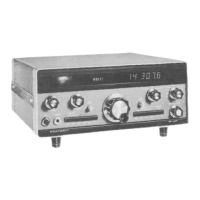Page
264
LOCALIZING THE TROUBLE
Before you look for any other circuit malfunction, be sure
a
If your Transceiver was in operation for a time and
you have the correct supply voltage. Do this by performing
then a difficulty showed up,
you can also refer to the
the first six steps under "Chassis" on Page 233. 'Test Chart" on Page 273.
Then localize your trouble to a particular area
(a single
circuit board for example) by using one or more of the
following methods:
Study the functional Block Diagram (fold-out from
Page
264)
and the 'Theory of Operation" (Page 319)
carefully. Then use deductive reasoning to pinpoint
your trouble to a
~ecific area. (If neither the
transmitter or receiver is operating, for example, look
for your trouble in one of the circuits that is common
to both of them, such as the VFO, the HFO, or a
carrier generator.)
Check the wiring of the under-chassis terminals from
the "Chassis Wiring Check List,"
foldaut from Page
300.
After you localize
the
trouble to one area:
Refer to the correct part of the "Maintenance" section
(Page 275) to troubleshoot any of the circuit boards.
Very carefully check the front panel, rear panel, and
chassis for any wiring errors or poor solder
i
connections.
i
!
1
a
Read "Voltage and Cont~nuity Checks" (Page 2721
before you make any measurements. Also refer to
"Checking Transistors and Diodes."
If
you h-mw your trouble is in the transmitter. or in
when
you
make
repain
on
the
~~~~~~i~~~,
be
sure
to
the receiver, or in
the
readout circuits, refer to one of
diminateboth
the
cwseand
effmtof
the
trouble,
~f,
for
the following sections:
example, you should find a damaged resistor, be sure you
find out what caused the resistor to become damaged
i
"Receiver Troubleshooting Guide"
. . .
.
Page
266
(wiring error, etc.). If the cause
is
not eliminated, the
"Transmitter Troubleshooting Guide'.'
.
. .
Page
268
replacement resistor may also be damaged when you turn
1
"Display Troubleshooting Guide"
. . .
.
Page 270 the Transceiver on again.
VFO/BUFFER TROUBLESHOOTING GUIDE
LSB
SHl
FT ADJUSTMENT
If
the LSB shift adjustment cannot be made, check the
DC
voltage at the anode (unbanded end) of Dl201 on the VFO
circuit board. When this diode
witch is working properly.
the anode voltage will
be
approximately 0.3 VDC when the
LSB
pushbutton is depressed, and 0 VDC when the USB
or
CW
button is depressed. Instructions for access to the VFO
circuit board are included in the following section.
VFO OUTPUT VOLTAGE
This section is for use when there is no VFO output voltage,
or the highest output voltage available is less than 0.35 VDC.
Use an RF voltmeter or an oscilloscope to make RF voltage
checks. Be sure to use a high input impedance voltmeter
(1
1
megohms or higher) when you make DC voltage
measurements at transistor leads to avoid erroneous readings
caured by loading the circuit.
If you get the correct RF voltage reading at the input lead of
a component but not at the output lead, the component is
probably faulty and
should be replaced. If the DC voltages
and the resistances measured
at
each lead (as shown in the
table at the end of this section) indicate variations of more
than
+20%, the resistors in the voltage path may have
changed value, the supply voltage may be in error, or a
transistor in the circuit could have an internal short circuit.
To check the components on the buffer circuit board,
remove the VFO assembly from the chassis and remove the
VFO shield
so
the circuit board is accessible. Reconnect the
two 4-wire connectors if they were disconnected during
disassembly.
1
If
you are checking the VFO after
it
has operated
satisfactorily in the Transceiver, remove the VFO
jumpey
plug from the VFO OUT socket on the rear panel
so
the
1
1
VFO will not be loaded during voltage measurements.
J

